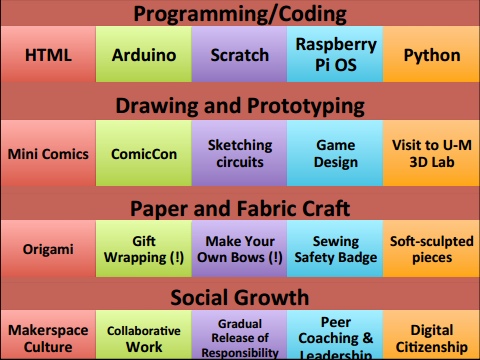It’s twelve months since Kristen Fontichiaro presented Sharpening our toolkit: defining great work, exploring Makerspace culture and badging accomplishments at the SLAV Conference Transliteracy: whom do you ask and how can you participate? At that time Kristen spoke of the value of Makerspaces as positive learning opportunities based on her experience and research with the Michigan Makers group and the University of Michigan, USA.
A number of schools have explored the idea and are implementing them in various ways. As a ‘third space’ in a student’s life – a place that is neither home and nor the classroom, libraries and the concept of a Makerspace is an ideal fit. Every school has a unique ‘maker’ identity according to the interests and resources available to that community. Some lean towards integration with STEM (Science, Technology, Engineering and Mathematics) and concentrate on electronics and coding. Others, such as Mazenod College library that I presented to delegates at the recent ELH conference, feature Lego, Minecraft, Kerbal Space Program and Augmented Reality.
Makerspaces: creating an opportunity
Regardless of the focus, Makerspaces share a common definition:
- A place where people can use tools and materials and can develop creative projects
- Can be embedded in an existing organisation or stand alone e.g. Makerfaires
- Are adaptive – can be shaped by educational goals or individuals’ creative interests Makerspace.com
Opportunities for innovation are emerging rapidly as schools purchase 3D printers and the notion of introducing computer coding as a primary school subject is being canvassed by education departments worldwide. There is an opportunity here for school library staff to look at their spaces and investigate the possibility of working in collaboration with Technology and IT Departments combining ideas across the school.
Schools libraries have the benefit of a degree of flexibility to venture into providing activities with a Makerspace mindset as an opportunity for students to tinker, explore, relax and mix with peers around a shared interest. It doesn’t have to be a fully equipped, technical space. Students simply need somewhere they can explore and learn in a voluntary yet constructive capacity.
Do you have a Makerspace story to share in relation to your school library? Please use the ‘reply’ box below to share your story.
Some resources to assist your research:
SLAV’s FYI journal – Summer 2014 – Theme- Makerspaces – the changing nature of school libraries includes numerous articles and a list of further reading
What does the next generation of school libraries look like? – Mindshift article by Luba Vangelova
Linking for learning – Makerspaces – list of resources
Makerbridge – an online community for everyone interested in makerspaces and maker culture
Edutopia – Maker education – a range of resources and practitioner advice including an excellent article by Vicki Davis
Makers as innovators – a series of books produced by the Michigan Makers, plus a list of ideas to consider
Invent to Learn – Making, tinkering and engineering in the classroom by Sylvia Martinez and Gary Stager.


